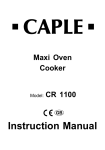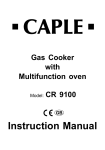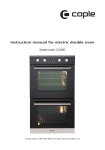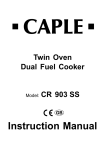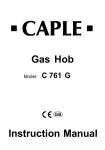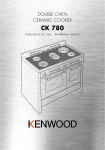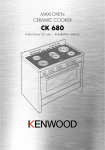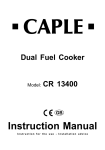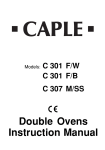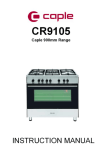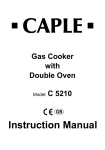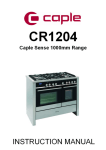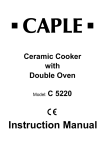Download Caple CR 1200 Instruction manual
Transcript
Twin Oven with Ceramic Cooker Model: CR 9220 Instruction Manual Thank you for buying your new CAPLE cooker. To ensure that you get the best results from your new CAPLE cooker, we strongly suggest that you read this instruction manual thoroughly before use. This manual contains installation advice, cleaning tips and a cooking guide, as well as other important facts about your CAPLE cooker. If treated with care, your CAPLE appliance should give you years of trouble-free cooking. For Spare Parts, Technical Advice or Product Service call the CAPLE HELPLINE on 0870 241 1142 (Answerphone outside office hours) Important: This appliance is designed solely for the cooking of domestic food and is not suitable for commercial use. This appliance incorporates a safety cooling fan which can be heard when the oven or grill are operating. The CE marking confirms that the appliance conforms to the following EU directives: - safety requirements of EEC Directive “Low voltage” 73/23; - protection requirements of EEC Directive “EMC” 89/336; - requirements of EEC Directive 93/68. 2 Safety Reminders Instruction Book This appliance should only be used for its intended purpose as described in these instructions. Ensure that you fully understand these instructions before operating this appliance. DO NOT line the oven, grids, trays etc. with aluminium foil as this could adversely affect the heating elements and it could also damage the interior surfaces. DO NOT place flammable materials in the oven or in the storage compartment. Space Requirements Ensure that the specified ventilation space around the appliance is not obstructed. Faults Do not continue to use this appliance if it appears to be faulty. Food Splashes Always wipe clean the oven after use. Food splashes can carry on cooking next time and may become a fire hazard. Hot Surfaces It is important to remember that the surfaces of cooking appliances get hot during use and retain the heat for some time after switching off. It is therefore advisable to keep small children away from the appliance. The Grill and Top oven element After Use Switch the oven controls off. Always switch off at the isolating switch before cleaning the appliance, or attempting any maintenance task, or when not in use for long periods (when on holiday). CAPLE Service To ensure the continued safe and efficient operation of this appliance, we recommend that any servicing or repairs are carried out only by an authorised CAPLE SERVICE ENGINEER. are exposed, so take great care when placing food in the oven or removing it. Use the grill pan handles or gloves. 3 Electrical Requirements WARNING! ELECTRICITY CAN BE EXTREMELY DANGEROUS. THIS APPLIANCE MUST BE EARTHED. For your safety please read the following information: This appliance must be installed by a qualified technician according with the current local regulations and in compliance with the manufacturer instructions. The appliance must be connected to the electrical network verifying above all that the voltage corresponds to the value indicated on the specifications plate and that the cables section of the electrical plant can bear the load which is also indicated on the plate. The cooker must be connected directly to the mains placing an omnipolar switch with minimum opening between the contacts of 3 mm between the appliance and the mains. The power supply cable must not touch the hot parts and must be positioned so that it does not exceed 75°C at any point. Once the cooker has been installed, the switch or socket must always be accessible. The connection of the appliance to earth is mandatory. The manufacturer declines all responsability for any inconvenience resulting from the inobservance of this condition. 4 1 - Electrical Installation - Wall box connection This appliance must be connected to a double pole isolating switch (fig. 1.1) and to the terminal block in the cooker (figs. 1.2, 1,3 & 1.4) using the following guide: DOUBLE POLE SWITCHED FUSED SPUR OUTLET 1) The wire which is coloured brown must be connected to the terminal marked L (Live), or coloured Red. 2) The wire which is coloured blue must be connected to the terminal marked N (Neutral), or coloured Black. 3) The wire which is coloured green and yellow must be connected to the terminal marked E (Earth) or coloured Green. IMPORTANT: These connections must be carried out by a qualified electrical engineer. FUSE ON USE A MINIMUM 65 AMP FUSE Fig. 1.1 IMPORTANT: This cooker must be connected to a suitable double pole control unit adjacent to the cooker. 5 Connecting the feeder cable Feedeer cable section “Type H05RR-F” To connect the feeder cable to the cooker it is necessary to: 230 V – Remove the two screws that hold shield A behind the cooker. (**) – Connection with wall box connection. – Contemporaneity factor applied 3 x 6 mm2 (**) – Open completely the cable clamp D. – Insert the mains cable (type H05 RRF) of minimum 6 mm2 section into the cable clamp D. – Connect the phase and earth cables to terminal B according figure 1.3 and 1.4. Fig. 1.3 230 V 1 2 3 4 5 – Pull the feeder cable and block it with the cable clamp D – Re-mount shield A. N.B. The earth conductor must be left about 3 cm longer than the others. L1 PE N L N (L2) PE Earth Neutral Live Fig. 1.4 1 2 B L1 3 4 5 N(L2) PE 230 V ~ D Fig. 1.2 6 A Red or Brown (Live) Black or Blue (Neutral) Green and Yellow (Earth) FOR THE INSTALLER 2 - Location The cooker must be installed by a qualified technician and in compliance with local safety standards. 750 mm The appliance must be kept no less than 50 mm away from any side wall which exceed the height of the hob surface (fig. 2.1). The appliance must be housed in heat resistant units. The walls of the units must be capable of resisting temperatures of 75 °C above room temperature. Do not install the appliance near inflammable materials (eg. curtains). If the cooker is located on a pedestal it is necessary to provide safety measures to prevent falling out. 50 mm 500 mm Fig. 2.1 7 Assembling the backguard Before installing the cooker, assemble the backguard “V” (fig. 2.2). Please note that : B • The backguard “V” can be found packed at the rear of the cooker. • Before assembling remove any protective film/adhesive tape. • The backguard must be fixed to the cooktop using the three supports “B” supplied with the appliance (see fig. 2.2). A V Fig. 2.2 Fitting the adjustable feet The adjustable feet must be fitted to the base of the cooker before use. Rest the rear of the cooker an a piece of the polystyrene packaging exposing the base for the fitting of the feet. Fig. 2.3 8 WARNING When raising cooker to upright position always ensure two people carry out this manoeuvre to prevent damage to the adjustable feet (fig. 2.4). WARNING Be carefull: do not lift the cooker by the door handle when raising to the upright position (fig. 2.5). WARNING When moving cooker to its final position DO NOT DRAG (fig. 2.6). Lift feet clear of floor (fig. 2.4). Fig. 2.4 Levelling the cooker The cooker may be levelled by screwing the lower ends of the feet IN or OUT (fig. 2.7). Fig. 2.5 Fig. 2.6 Fig. 2.7 9 3 - Features and Technical Data 2 4 3 1 6 5 Fig. 3.1 Vitroceramic cooking hob - (Fig. 4.1) 1. 2. 3. 4. 5. 6. Radiant cooking zone Ø 180 Radiant cooking zone Ø 145 Oval cooking zone Ø 140 x 250 Double cooking zone Ø 210/120 Radiant cooking zone Ø 145 Cooking zone residual heat indicators 1700 W 1200 W 1800/1000 W 2100/700 W 1200 W Attention: Detach the appliance from the mains if the ceramic hob is cracked. 10 Fig. 3.2 A U T O 8 7 11 6 5 4 13 3 2 1 10 12 9 Control panel - Controls description 1. Front right cooking zone control knob 2. Rear right cooking zone control knob 3. Central cooking zone control knob 4. Rear left cooking zone control knob 5. Front left cooking zone control knob 6. Multifunction main oven switch knob 7. Multifunction main oven temperature knob 8. Electronic programmer (main oven only) 9. Conventional oven temperature knob 10. Conventional oven switch knob Pilot lamps: 11. Main oven temperature indicator light 12. Conventional oven temperature indicator light 13. Ceramic hob ON indicator light 11 How To Use the Cooking Hob The ceramic surface of the hob allows a fast transmission of heat in the vertical direction, from the heating elements underneath the ceramic glass to the pans set on it. The heat does not spread in the horizontal direction, so that the glass stays “cool” at only a few centimeters from the cooking plate. 3 circuits radiant zones Incorporating 3 heating elements (fig. 3.4) you can control and light up all together or separately by a 6 position switch (fig. 3.3). Reaches the working temperature in a very short time. The 5 cooking zones are shown by dark disks on the ceramic surface. 12 Fig. 3.3 Fig. 3.4 Double and oval radiant zones The heating element is formed of a coil of resistant material which reaches the working temperature quickly. Operation of the cooking zone is controlled by a continuous energy regulator from “1” to “12” (maximum temperature) (fig. 3.5). By switching on the second element (fig. 3.6 and 3.7), the surface area of the rear right and central radiant zones can be extended. For this purpose, turn the control knob (fig. 3.5) fully to the right (position ). Fig. 3.5 Second element Fig. 3.6 Second element Fig. 3.7 13 Cooking hints Cooking plate controlled by a 6 position switch Cooking plate controlled by a 12 position switch Knob setting 0 0 Switched OFF 1 2 1 2 For melting operations (butter, chocolate). 2 2 3 4 To keep food hot and to heat small quantities of liquid (sauces, eggs). 3 4 5 6 To heat bigger quantities; to whip creams and sauces. (vegetables, fruits, soups). 3 4 6 7 Slow boiling, i.e.: boiled meats, spaghetti, soups, continuous steam cooking of roasts, stews, potatoes. 4 7 8 For every kind of frying, cutlets, uncovered cooking, i.e.: risotto. 4 5 8 9 10 Browning of meats, roasted potatoes, fried fish, omelettes, and for boiling large quantities of water. 6 11 12 Fast frying, grilled steaks, etc. 1 1 2 3 2 4 Type of cooking 5 3 6 7 4 8 9 10 5 11 12 6 Heating Switching on the second element (Double and oval radiant plate only) Cooking Roasting-frying 14 Fig. 3.8 After a short period of use, experience will teach you which setting is the right one for your needs. Residual heat indicator The hob also features 5 warning lamps which are wired to the corresponding plate. When the temperature of a cooking plate is over 60°C, the relevant warning lamp is also lit-up to warn of heat on the surface of the hob. This lamp also stay on after the cooking plate has been switched off to shown that the hob surface is still hot. This residual heat lasts for a rather long time after the cooking plate has been switched off. During this period of time you should avoid touching the hob surface over the cooking area. Please pay special attention to ensuring children are not allowed near the hob. The lamp will switch off automatically as soon as the surface temperature of the cooking plate falls below 60°C. Cooking hints: – To reduce the cooking time, you can turn the control knob to the max when you switch the plate on. After a short time you will set the control knob to the required position for the cooking. – You should use pots and pans with flat bases (pans with the test mark for glass-ceramic hobs are available from specialist shops). The diameter of the pan should match that of the cooking plate (or be slightly bigger) to make the most of the energy. – Since the cooking surface stays hot for a certain time after the plate has been switched off, you can switch it off 5 or 10 minutes before the end of the cooking. The residual heat of the hob will complete the cooking. – To save electricity, use pan lids whenever possible. – Never cook the food directly on the glass ceramic cooktop, but in special pans or containers. Caution! the cooking hob becomes very hot during operation. Keep children well out of reach. Fig. 3.9 15 Safety hints: Cleaning – Before you switch the hob on, make sure you know which knob controls the required cooking plate. We advise you to set the pan over the cooking plate before switching it on. Remove the pan after you have switched the cooking plate off. – Do not use pots and pans with rough bases (pay attention to cookware made of cast-iron). Rough bases can damage (scratch) the glass surface of the hob. Make sure that the pan bottom of the pan is dry and clean. – Pots with aluminium bottoms may leave silver streaks or spots on the hob. – Do not leave wet or damp lids on the hob. – The glass-ceramic surface and pans must be clean. Carefully remove any food debris (especially containing sugar), dirt etc. with the aid of a cleansing agent. – Pan handles should never stand out beyond the kitchen worktop, as there is a great danger of knocking the pan over. This will also ensure that children cannot reach them. – Do not use the hob if the glass surface is broken or cracked in any way. Please disconnect the hob from the mains and contact the aftersales service. – Do not lean over the cooking plate when in use. – Do not lay cooking foil or plastic materials on the ceramic surface when it is hot. – Remember that the surface remains hot for a long time (about 30 min.) after the cooking plate has been switched off. – Follow the cleaning instructions carefully. Before you begin cleaning make sure that the appliance is switched off. Do not use the glass surface for storage. 16 Remove spillages and other types of incrustations. Dust or food particles can be removed with a damp cloth. If you use a detergent, please make sure that it is not abrasive or scouring. Abrasive or scouring powders can damage the glass surface of the hob. All traces of the cleaner must be removed with a damp cloth. Do not put articles on the hob which can melt: i.e plastic, aluminium foil, sugar, sugar syrup mixtures etc. If any of these products items have melted on the ceramic surface, you should remove it immediately (when the surface is still hot) by using a scraper to avoid any permanent damage to the surface of the hob. Avoid using a knife or other sharp utensils since these can damage the ceramic. Do not use steel wool or an abrasive sponge which could scratch the surface permanently. ATTENTION: MOST IMPORTANT! If cleaning the glass ceramic hob using a special scraper tool take extra care to avoid damaging to the seal at the edges of the glass ceramic surface. Fig. 3.10 4 - How To Use the Multi-function main oven Attention: the oven door becomes very hot during operation. Keep children away. General features As its name indicates, this is an oven that presents particular features from an operational point of view. In fact, it is possible to insert 7 different programs to satisfy every cooking need. The 7 positions, thermostatically controlled, are obtained by 4 heating elements which are: – – – – – – Bottom element Top element Grill element Circular element Fan motor Oven lamp 1400 W 1000 W 2000 W 2500 W 25 W 15 W NOTE: Upon first use, it is advisable to operate the oven for 30 minutes in the position and for another 30 minutes at the maximum temperature (thermostat knob on position 250) in the positions , to elimand inate possible traces of grease on the heating elements. Clean the oven and accessories with warm water and washing-up liquid. WARNING: The door is hot, use the handle. OPERATING PRINCIPLES Heating and cooking in the MULTIFUNCTION oven are obtained in the following ways: a. by normal convection The heat is produced by the upper and lower heating elements. b. by forced convection A fan sucks in the air contained in the oven muffle, which sends it through the circular heating element and then sends it back through the muffle. Before the hot air is sucked back again by the fan to repeat the described cycle, it envelops the food in the oven, provoking a complete and rapid cooking. It is possible to cook several dishes simultaneously. c. by semi-forced convection The heat produced by the upper and lower heating elements is distributed throughout the oven by the fan. d. by radiation The heat is irradiated by the infra red grill element. e. by radiation and ventilation The irradiated heat from the infra red grill element is distributed throughout the oven by the fan. f. by ventilation The food is defrosted by using the fan only function without heat. 17 Thermostat knob (fig. 4.1) To turn on the heating elements of the oven, set the switch knob on the desired program and the thermostat knob onto the desired temperature. To set the temperature, it is necessary to make the knob lever meet the chosen number. The elements will turn on or off automatically according to the energy need which is determined by the thermostat. The operation of the heating elements is signalled by a light above the thermostat knob. Function selector knob (fig. 4.2) Rotate the knob clockwise to set the oven for one of the following functions: 18 Fig. 4.1 Oven light By turning the knob onto this setting we light the oven cavity (15 W). The oven remains alight while any of the functions is on. Traditional convection cooking The upper and lower heating elements are switched on. The heat is diffused by natural convection and the temperature must be regulated between 50° C and 250° C with the thermostat knob. It is necessary to preheat the oven before introducing the foods to be cooked. Recommended for: For foods which require the same cooking temperature both internally and externally, i. e. roasts, spare ribs, meringue, etc. Fig. 4.2 Grilling The infra-red heating element is switched on. The heat is diffused by radiation. Use with the oven door closed and the thermostat knob to between 50° and 225°C for max 15 minutes, then to position 175°C. Note: It is recommended that you do not grill for longer than 30 minutes at any one time. Attention: the oven door becomes very hot during operation. Keep children away. For correct use see chapter “USE OF THE GRILL”. Recommended for: Intense grilling action for cooking with a broiler; browning, crisping, “au gratin”, toasting, etc. Defrosting frozen foods Only the oven fan is on. To be used with the thermostat knob on “●” because the other positions have no effect. The defrosting is done by simple ventilation without heat. Recommended for: To rapidly defrost frozen foods; 1 kilogram requires about one hour. The defrosting times vary according to the quantity and type of foods to be defrosted. Hot air cooking The circular element and the fan are on. The heat is diffused by forced convection and the temperature must be regulated between 50° and 250 °C with the thermostat knob. It is not necessary to preheat the oven. Recommended for: For foods that must be well done on the outside and tender or rare on the inside, i. e. lasagna, lamb, roast beef, whole fish, etc. Ventilated grill cooking The infra-red ray grill and the fan are on. The heat is mainly diffused by radiation and the fan then distributes it throughout the oven. The temperature must be regulated between 50° and 175 °C for max 30 minutes, with the thermostat knob. It is necessary to preheat the oven for about 5 minutes. Use with the oven door closed. Attention: the oven door becomes very hot during operation. Keep children away. For correct use see chapter “GRILLING AND “AU GRATIN”. Recommended for: For grill cooking when a fast outside browning is necessary to keep the juices in, i. e. veal steak, steak, hamburger, etc. 19 Maintaining temperature after cooking or slowly heating foods The upper element and the circular element connected in series, are switched on; also the fan is on. The heat is diffused by forced convection with the most heat being produced by the upper element. The temperature must be regulated between 50° and 140 °C with the thermostat knob. Recommended for: To keep foods hot after cooking. To slowly heat already cooked foods. Convection cooking with ventilation The upper and lower heating elements and the fan turn on. The heat coming from the top and bottom is diffused by forced convection. The temperature must be regulated between 50° and 250 °C with the thermostat knob. Recommended for: For foods of large volume and quantity which require the same internal and external degree of cooking; for ie: rolled roasts, turkey, legs, cakes, etc. 20 Cooking Advice Sterilization Sterilization of foods to be conserved, in full and hermetically sealed jars, is done in the following way: a. Set the switch to position . b. Set the thermostat knob to position 185 °C and preheat the oven. c. Fill the dripping pan with hot water. d. Set the jars onto the dripping pan making sure they do not touch each other and the door and set the thermostat knob to position 135 °C. When sterilization has begun, that is, when the contents of the jars start to bubble, turn off the oven and let cool. Regeneration Set the switch to position and the thermostat knob to position 150° C. Bread becomes fragrant again if wet with a few drops of water and put into the oven for about 10 minutes at the highest temperature. Roasting To obtain classical roasting, it is necessary to remember: – that it is advisable to maintain a temperature between 180 and 200 °C. – that the cooking time depends on the quantity and the type of foods. Grilling and “au gratin” Use of the grill Set the switch to position . Set the thermostat to position 175 °C and after having preheated the oven, simply place the food on the shelf. Close the door and let the oven operate with the thermostat on, until grilling is complete. Adding a few dabs of butter before the end of the cooking time gives the golden “au gratin” effect. Note: It is recommended that you do not grill for longer than 30 minutes at any one time. Preheat the oven for about 5 minutes. ATTENTION: the oven door becomes very hot during operation. Keep children away. Simultaneous cooking of different foods The MULTI-FUNCTION oven set on position gives simultaneous and heterogeneous cooking of different foods. Different foods such as fish, cake and meat can be cooked together without mixing the smells and flavours. This is possible since the fats and vapors are oxidized while passing through the electrical element and therefore are not deposited onto the foods. The only precautions to follow are: – The cooking temperatures of the different foods must be as close to as possible, with a maximum difference of 20° - 25 °C. – The introduction of the different dishes in the oven must be done at different times in relation to the cooking times of each one. Introduce the food to be cooked, positioning the rack as close to the grill as possible. The drip pan should be placed under the rack to catch the cooking juices and fats. Grilling with the oven door closed. Do not grill for longer than 30 minutes at any one time. Caution: the oven door becomes very hot during operation. Keep children well out of reach. Oven cooking Before introducing the food, preheat the oven to the desired temperature. For a correct preheating operation, it is advisable to remove the tray from the oven and introduce it together with the food, when the oven has reached the desired temperature. Check the cooking time and turn off the oven 5 minutes before the theoretical time to recuperate the stored heat. The time and energy saved with this type of cooking is obvious. 21 5 - How To Use the Conventional oven General features The conventional oven is provided with 3 heating elements which are: – Top element 700 W – Bottom element 800 W – Grill element 1600 W NOTE: Upon first use, it is advisable to operate the oven for 30 minutes in the position and for another 30 minutes at the maximum temperature (thermostat knob on position 225) in the position to eliminate possible traces of grease on the heating elements. WARNING: The door is hot, use the handle. Thermostat (Fig. 5.2) This only sets the cooking temperature and does not switch the oven on. Rotate clockwise until the required temperature is reached (from 50 to 250°C). The light above the function selector will illuminate when the oven is swiched on and turns off when the oven reaches the correct temperature. The light will cycle on and off during cooking in line with the oven temperature. Fig. 5.1 22 Fig. 5.2 Function selector knob (fig. 5.1) Rotate the knob clockwise to set the oven for one of the following functions. Oven light By setting the knob to this position, only the oven light comes on (15 W). It remains on in all the cooking modes. Traditional convection cooking The upper and lower heating elements come on. The heat is dispersed by natural convection and the temperature must be set to between 50° and 250°C via the thermostat knob. The oven must be preheated before cooking. In the position the rotisserie motor come on for cooking with the rotisserie. Recommended for: Food that requires the same degree of cooking both inside and out, for example roasts, spare pork ribs, meringues etc. Traditional grilling The infrared electrical resistance comes on. The heat is diffused by radiation. Use with the oven door closed and the thermostat knob to position 225°C for 15 minutes then to 175°C. In the position the rotisserie motor come on for cooking with the rotisserie. For cooking hints, see the chapter “USE OF THE GRILL”. Recommended for: Intense grilling, browning, cooking au gratin and toasting etc. It is recommended that you do not grill for longer than 30 minutes at any one time. Attention: the oven door becomes very hot during operation. Keep children away. 23 Use of the grill Switch the grill on, setting the two knobs: – Function selector to or position. – Thermostat selector to position 225°C for 15 minutes then to 175°C. Leave to warm up for approximately 5 minutes with the door closed. Place the food inside positioning the rack as near as possible to the grill. Insert the drip pan under the rack to collect the cooking juices. Grilling with the oven door closed and do not for longer than 30 minutes at any one time. Grill with the oven door closed. Do not grill for longer than 30 minutes at any one time. Attention: the oven door becomes very hot during operation. Keep children away. Rotisserie The oven is equipped with a rotisserie. This device is made up of: – an electrical motor mounted on the rear part of the oven – a stainless steel rod, equipped with a detachable athermic grip and 2 recordable forks – a rod support to be inserted into the central rack holders of the oven. Use of the rotisserie – Insert the dripping pan into the lowest rack holders of the oven and insert the rod support into the intermediate rack holders. – Put the meat to be cooked onto the rod, being careful to secure it in the center with the special forks. – Insert the rod into the motor opening and rest it onto the support of the spit collar; then remove the grip by turning it to the left. The rotation direction of the rotisserie can be either clockwise or counterclockwise. Grill with the oven door closed. Attention: the oven door becomes very hot during operation. Keep children away. It is recommended that you do not grill for longer than 30 minutes at any one time. Fig. 5.3 24 Recommended cooking temperature Food °C °F Gas Mark Shelf Position* Cooking Time (approx) CAKES Victoria sandwich Small cakes/buns Maidera cake Fruit cake Rich fruit cake Scones 190 190 180 170 150 225 375 375 350 325 300 425 5 5 4 3 2 8-9 2 or 3 1 and 2 2 or 3 3 3 or 4 2 20-25 mins 15-20 mins 20 mins 13/4 hours 21/2 hours 8-10 mins PASTRY Puff Short crust Plate tarts Quiches and flans 225 200 200-210 200-210 425 400 400-410 400-410 8-9 6 6 6 2 2 1 or 2 1 or 2 10-20 20-30 30-35 40-45 225 220 230 425 425 450 7-8 7 8 2 1 or 2 2 35-55 mins 15-20 mins 20 mins 190 190 190-200 190 190 180 150-170 375 375 375-400 375 375 350 300-325 5 5 5-7 5 5 4 2-3 2 2 2 2 2 2 2 YEAST Bread loaf Bread rolls Pizza dough ROAST MEAT Beef – Medium Lamb Pork Veal Chicken Turkey up to 10lb Stews/casseroles N.B. For fan ovens reduce the temperature by 10-20°C. For any dish taking one hour or over to cook, reduce the cooking time by 10 minutes per hour. or or or or or or or 3 3 3 3 3 3 3 mins mins mins mins 20 mins/lb + 20 mins 25-30 mins/b + 25 mins 30 mins/lb + 30 mins 30 mins/b + 30 mins 30 mins/b + 30 mins 18-20 mins/b + 20 mins 11/2 2 hours * Shelf positions have been counted from the top of the oven to the base. A fan oven creates more even temperature throughout, therefore the shelf positions are not as critical. 25 6 - Electronic programmer (main oven only) The electronic programmer is a device which groups together the following functions: ■ 24 hours clock with illuminated display ■ Timer (up to 23 hours and 59 minutes) ■ Program for automatic oven cooking ■ Program for semi-automatic oven cooking. Description of the buttons: Automatic cooking taking place Timer Cooking time End of cooking time Manual position and cancellation of the inserted cooking program Advance of the numbers of all programs Turning back of the numbers of all programs and changing the frequency of the audible signal. Description of the lighted symbols: Timer in operation and AUTO - flashing - Program error. (The time of day lies between the calculated cooking start and end time). Note: Select a function by the respective button and, in 5 seconds, set the required time with the / buttons (“onehand” operation). A power cut makes the clock go to zero and cancels the set programs. AUTO - flashing - Programmer in automatic position but not programmed AUTO - always lighted - Programmer in automatic position with program inserted. A U T O 26 Fig. 6.1 Fig. 6.2 Electronic clock (fig. 6.2) The programmer is equipped with an electronic clock with lighted numbers which indicates hours and minutes. Upon immediate connection of the oven or after a power cut, three zeros will flash on the programmer panel. To set the hour it is necessary to push the button and then the or button until you have set the exact hour (fig. 4.2). Another way is to simultaneously push the two buttons and at the same time push the or button. Nota: Changing the hour button deletes any cooking program. Normal cooking without the use of the programmer To manually use the oven, that is, without the aid of the programmer, it is necessary to cancel the flashing AUTO by pushing the button (AUTO will be switched off and the symbol will go on - Fig. 6.3). Attention: If the AUTO symbol is steady a cooking program has already been programmed, by pushing the button you have cancelled of the program and the switched to manual. If the oven is switch on, you must switch off manually. Electronic timer The timer program consists only of a buzzer which may be set for a maximum period of 23 hours and 59 minutes. If the AUTO flashing push the button. To set the time, push the button and the or until you obtain the desired time in the panel (fig. 6.4). Having finished the setting, the clock hour will appear on the panel and the symbol will be lighted. The countdown will start immediately and may be seen at any moment on the panel by simply pressing the button At the end of the time, the symbol will be switched off and an intermittent buzzer will go off; this can be stopped by pressing one of any of the buttons. Setting the frequency of the audible signal The selection from 3 possibilities of sound can be made by pressing the button. A U T O Fig. 6.3 Fig. 6.4 27 Automatic oven cooking To cook food automatically in the oven, it is necessary to: 1. Set the length of the cooking time 2. Set the end of the cooking time 3. Set the temperature and the oven cooking program. These operations are done in the following way: 1. Set the length of the cooking time by pushing the button and the button to advance, or to go back if you have passed the desired time (fig. 6.5). The AUTO and the symbol will be on. 2. Set the end of the cooking time by pressing the button (the cooking time already added to the clock time will appear), and the button (fig. 6.6); if you pass the desired time you may get back by pushing the button. After this setting, the symbol will go off. If after this setting, the AUTO flash on the panel and a buzzer gives off, it means there was an error in the programming. In this case, modify the end of cooking time or the cooking time itself by following again the above mentioned instructions. 3. Set the temperature and the cooking program by using the switch and thermostat knobs of the oven (see specific chapters). Now the oven is programmed and everything will work automatically, that is the oven will turn on at the right moment to end the cooking at the established hour. During cooking, the symbol remains on. By pushing the button you can see the time that remains until the end of cooking. The cooking program may be cancelled in any moment by pushing . At the end of the cooking time the oven will turn off automatically, the symbol will turn off, AUTO will flash and a buzzer will sound, which can be turned off by pushing any of the bottons. Turn the switch and thermostat knobs to zero and put the programmer onto “manual” by pressing the button. Attention: A power cut makes the clock go to zero and cancels the set programs. After a power cut, three zeros will flash on the panel. A U T O A U T O 28 Fig. 6.5 Fig. 6.6 Semi-automatic cooking This function is only used to set the END of the cooking time of the oven. There are two ways of setting this function. 1. Set the length of the cooking time by pushing the button and the button to advance, or to go backwards (Fig. 6.7). This sets the desired “stop” time. At the end of the cooking, the symbol will turn off, the AUTO will flash and a buzzer will sound. The buzzer can be cancelled by pressing any of the buttons. Turn the switch and thermostat knobs to zero and reset the programmer back to “manual” by pressing the button. or 2.Set the end of the cooking time by pushing the button and the button to advance, or to go backwards if you have passed the desired time (Fig. 6.8). AUTO and the symbol will be on. Then set the temperature and the cooking program using the oven switch and thermostat knob (see relevant sections for details). The oven is switched on and it will be switched off automatically at the end of the desired time. During cooking, the symbol remains on and by pressing the button you can see the time that remains till the end of the cooking. The cooking time can be cancelled at any moment by pushing the button. A U T O Fig. 6.7 A U T O Fig. 6.8 29 7 - Cleaning and Maintenance General advice – Important: Before any operation of cleaning and maintenance disconnect the appliance from the electrical network. Cleaning All the enamelled parts must be cleaned with a sponge and soapy water or other nonabrasive products. Dry preferably with a soft cloth. Acidic substances like lemon juice, tomato sauce, vinegar etc. can damage the enamel if left too long. Stainless steel surfaces The stainless steel front panels on this cooker (facia, oven door, storage compartment) are protected by a finger-print proof lacquer. To avoid damaging this lacquer, do not clean the stainless steel with abrasive cleaners or abrasive cloths or scouring pads. ONLY SOAP/WARM WATER MUST BE USED TO CLEAN THE STAINLESS STEEL SURFACES. Vitroceramic cooking hob – See page 16 Attention The appliance gets very hot, mainly around the cooking areas. It is very important that children are not left alone in the kitchen when you are cooking. Do not use a steam cleaner because the moisture can get into the appliance thus make it unsafe. 30 Replacing the oven light bulb Assembly and dismantling of the side runner frames Switch the cooker off at the mains. When the oven is cool unscrew and replace the bulb with another one resistant to high temperatures (300°C), voltage 230 V (50 Hz), 15 W, E14. Note: Oven bulb replacement is not covered by your guarantee. – Fit the side runner frames into the holes on the side walls inside the oven (Fig. 7.1). – Slide the tray and rack into the runners (Fig. 7.2). – To dismantle, operate in reverse order. Inside of oven This must be cleaned regularly. Remove and refit the side runner frames as described on the next chapter. With the oven warm, wipe the inside walls with a cloth soaked in very hot soapy water or another suitable product. Side runner frames, tray and rack can be removed and washed. Fig. 7.1 Fig. 7.2 31 Fig. 7.3 Oven doors Storage compartment The internal glass panel can be easily removed for cleaning by unscrewing the 2 retaining screws (Fig. 7.3) The storage compartment is accessible through the pivoting panel (fig. 7.4). Do not store flammable material in the oven or in the storage compartment. Fig. 7.4 32 Removing the oven door Fig. 7.5A The oven door can easily be removed as follows: – Open the door to the full extent (fig. 7.5A). – Attach the retaining rings to the hooks on the left and right hinges (fig. 7.5B). – Hold the door as shown in fig. 7.5. – Gently close the door and withdraw the lower hinge pins from their location (fig. 7.5C). Fig. 7.5B – Withdraw the upper hinge pins from their location (fig. 7.5D). – Rest the door on a soft surface. – To replace the door, repeat the above steps in reverse order. Fig. 7.5C Fig. 7.5D Fig. 7.5 33 Helpful Advice Trouble shooting Problem Food too brown but not cooked. Remedy Turn down the oven temperature slightly and cook a little longer Problem Food cooked but not brown enough. Remedy Increase temperature. Problem Food baking unevenly. Remedy 1. The temperature may be slightly high turn it down 2. Position the food in the centre of the shelves rather than towards the sides of tho oven. 3. Rotate the food a half turn in the oven. 4. Try pre-heating the oven for 5-15 minutes prior to baking. Always remove cooked items as soon as they are ready and continue cooking the under-cooked items until they are completely finished. Changing the Oven Cavity Light Bulb. If the oven light falls: 1. Turn off the cooker by switching the oven selector to 0, switch off at the cooker point. 2. When the oven is cool, reach back and upwards inside the oven, the bulb is in the top left corner (main oven) or on the top of the cavity in central position (right oven). 3. Unscrew the light glass cover, replace the bulb with a new one of the same specification and screw the cover back until it is hand tight. NOTE: Oven bulb replacement is not covered by your guarantee. Other bulbs cannot be changed by yourself and should be replaced by an authorised CAPLE Service Engineer. 34 IMPORTANT: Ovens get hot. Keep children away from this appliance at all times. If Your Oven Does Not Work Before calling a CAPLE service engineer run through the following checklist. 1. The cooker is connected to the power supply and that the fuse is intact. 2. Make sure the timer control is set to the manual position, and that the oven has not been set inadvertently for an automatic or timed programme (main oven only). If you are in any doubt about carrying out these checks, call the CAPLE Helpline on 0870 241 1142. A charge will be made if the appliance is found to be in working order, or if it has not been installed in accordance with these instructions, or if it is has been used incorrectly. 35 CAPLE “Built-in” Service Should you require service at any time, please contact the Caple Helpline on 0870 241 1142. Caple have a nationwide service network of engineers who will respond quickly to your call. Always replace spare parts with genuine Caple spares. These are available from authorised Caple Service Centres or by mail order from our National Service Stores, simply telephone 0870 241 1142. When ordering parts always quote the model number and serial number of your appliance. YOUR GUARANTEE CAPLE guarantees all parts of this product for one year from the date of purchase. During that time, should it become necessary CAPLE engineers will replace or repair all defective parts free of charge, except for parts subject to fair wear and tear, such as lightbulbs. Parts and the engineers labour costs are chargeable after the first 12 months. To qualify for benefits under the guarantee, you must be able to provide proof of date of purchase and the appliance must have been supplied, installed and used for domestic purposes only in accordance with CAPLE instructions. Consequential losses and accidental damage to the product are not covered by the guarantee. This guarantee does not affect your statutory or common law rights. ß3 CAPLE cannot be responsible for the results of using this appliance for any other purposes other than those described in these instructions. Cod. 1102106




































